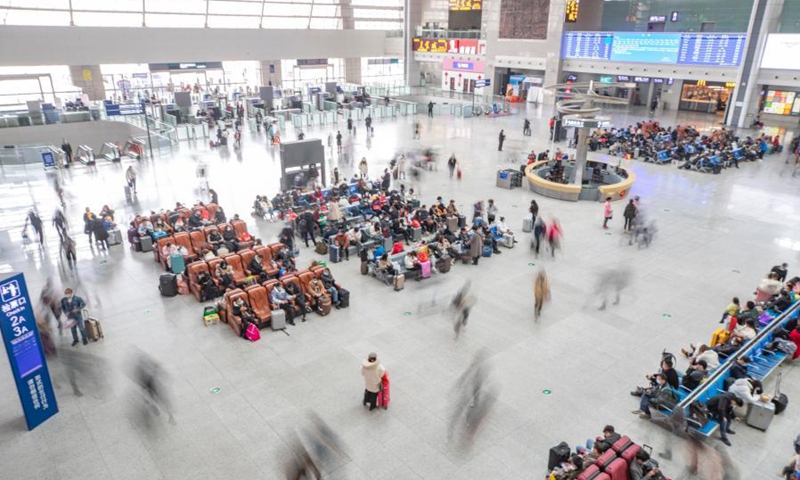
Passengers are seen in a waiting hall at Chongqingbei Railway Station in Chongqing, southwest China, Feb. 17, 2021. Wednesday marks the last day of the Spring Festival holiday. As railway stations entered the travel rush of returning passengers, Chongqing railroad department took messures to ensure that passengers travel easily and safely. Photo:Xinhua
China's passenger trips for the Chinese New Year or Spring Festival travel rush, the world's largest annual human migration to take place from January 17 to February 25, are expected to double last year's numbers, Cai Tuanjie, spokesperson of the Ministry of Transport, announced in the preliminary estimations on Friday.
While travel during the holidays is expected to record a big jump, it is still only half of what it was on the same period before the epidemic.
The travel rush, which overlaps with the Winter Olympic Games and the two political sessions that come after, gives signs about the foreseeable severity of the epidemic prevention and control tasks ahead, Cai mentioned during the press conference by the State Council Information Office.
"The passenger volume during the Chinese Spring Festival in 2022 will increase substantially compared to this year, and even double that of 2020," Cai said.
The Spring Festival travel period in 2022 will have last for 40 days, starting from January 17 to February 25, which overlaps with the Beijing Winter Olympic Games to be held between February 4 and 20.
To guarantee a smooth travel during the holidays while ensuring the effective epidemic prevention is in place, the ministry is already on the move ahead of the festivities.
Part of the transportation plan for the Beijing Winter Olympics will be activated on January 4 next year and a 55-day comprehensive transportation scheme will be officially launched on January 21, Cai mentioned.
The Ministry of Transport, in conjunction with relevant departments and units, has set up a special work team for the upcoming Spring Festival travel rush to coordinate the prevention and control of the epidemic, according to the announcement.
Up to now, with the joint efforts of all parties, the Winter Olympics transportation infrastructure has all been put into service.
The Spring Festival travel rush saw a total of 1.476 billion passenger trips in 2020, a year-on-year decrease of 50.3 percent.
Despite the growth for the upcoming holiday travel rush, passenger trips are still only half of what they were in 2019 before the epidemic, and might not fully recover until 2023, Mao Baohua, professor of traffic systems at the Beijing Jiaotong University, told the Global Times on Friday.
Moreover, the travel rush will vary from place to place. For example, Beijing, host the Winter Olympic Games to be held is expected to see limited traffic flow, while other cities, especially in Central and Southern China, will see bigger passenger flows, Mao said.
The current number of migrant workers has also been slashed compared to before the epidemic and has not fully recovered. This also indicates a limited flow in the coming holiday rush, Mao said.




